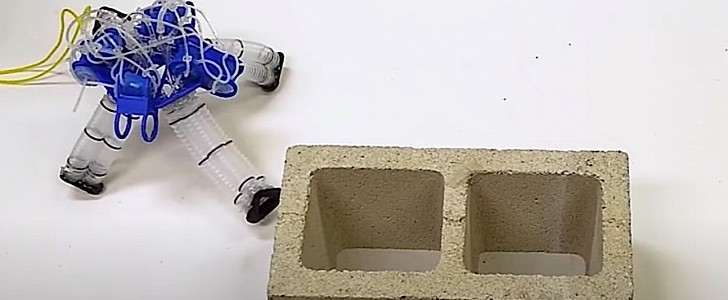Generally speaking, the term robot designates some type of large mechanical metal monstrosity designed to fulfill whatever task humans need fulfilling. But there other types of robots out there, and they are even spookier.
One such breed is that of soft robots. These are machines built from materials meant to mimic the ones usually found in living organisms, and capable of adapting to their environment. People are working on such creepy creations in the hopes of coming up with new technologies to use in anything from invasive surgery to exosuits.
Being such a revolutionary concept, soft robots have, of course, caught the eye of the military. The Office of Naval Research, for instance, is backing a project of a team from the University of California San Diego that seeks to create a robot that works with no electronics, and needs just pressurized air to move and power itself.
The four-legged machine was presented earlier this month by the team’s leader, Michael T. Tolley, a professor of mechanical engineering at the Jacobs School of Engineering at UC San Diego. It is said to have been inspired, at least as far as its gait goes, by sideneck turtles.
So, how does this thing, nicknamed Airwalker, work?
There are three valves on the beast that open to allow air from a small pressurized container up top to go through each of the legs, depending on needs. Each leg, angled downward at 45 degrees, is linked to three parallel and connected pneumatic cylindrical chambers that allow them to bend and move the machine. Or, in simpler words, air blows through some holes, and the robot flexes its limbs accordingly.
The extraordinary thing about this is that, according to the team, it needs no electronics to work. Their place as the brain of the machine was taken by pneumatic circuits, made up of tubes and soft valves, while simple mechanical sensors give it situational awareness.
Scientists say the whole contraption “mimics mammalian reflexes that are driven by a neural response from the spine rather than the brain.” For now, it can only move around on straight surfaces and avoid obstacles, but off-road capabilities, if they can be called that, are next on the list of objectives for the team.
As for the ways such a robot could be used, we’re told they should fit right in performing tasks in mine shafts, for instance, or form the basis of the next generation of toys. You know, because the Office of Naval Research is all about toys...
Being such a revolutionary concept, soft robots have, of course, caught the eye of the military. The Office of Naval Research, for instance, is backing a project of a team from the University of California San Diego that seeks to create a robot that works with no electronics, and needs just pressurized air to move and power itself.
The four-legged machine was presented earlier this month by the team’s leader, Michael T. Tolley, a professor of mechanical engineering at the Jacobs School of Engineering at UC San Diego. It is said to have been inspired, at least as far as its gait goes, by sideneck turtles.
So, how does this thing, nicknamed Airwalker, work?
There are three valves on the beast that open to allow air from a small pressurized container up top to go through each of the legs, depending on needs. Each leg, angled downward at 45 degrees, is linked to three parallel and connected pneumatic cylindrical chambers that allow them to bend and move the machine. Or, in simpler words, air blows through some holes, and the robot flexes its limbs accordingly.
The extraordinary thing about this is that, according to the team, it needs no electronics to work. Their place as the brain of the machine was taken by pneumatic circuits, made up of tubes and soft valves, while simple mechanical sensors give it situational awareness.
Scientists say the whole contraption “mimics mammalian reflexes that are driven by a neural response from the spine rather than the brain.” For now, it can only move around on straight surfaces and avoid obstacles, but off-road capabilities, if they can be called that, are next on the list of objectives for the team.
As for the ways such a robot could be used, we’re told they should fit right in performing tasks in mine shafts, for instance, or form the basis of the next generation of toys. You know, because the Office of Naval Research is all about toys...


